Topic 1: Cell biology 
This page contains multiple choice questions in the style of Paper 1 of the Biology exams.
They test the breadth of your knowledge of the understandings and skills about cell biology.
To spend more time reviewing the topic before answering these questions, use the revision resources.
Cell biology revision resources
This page lists the understandings and skills expected for Topic 1 and links to the sub-topic pages which contain detailed revision notes, activities and past paper style questions. Great for revision.
Learn from any mistakes. Every question has an examiner's explanation that appears when you check your answers.
Pasteur's experiment with 'swan neck' flasks showed that a sterile nutrient medium exposed to the air would not show any signs of bacterial growth under his conditions.
What prevented the growth of bacteria?
Pasteur's famous experiments with swan neck flasks showed that broth kept in a flask where no dust could settle in the nutrient medium, and thus no living cells could get in, would not go mouldy.
This disproved the theory of spontaeous generation.
The image below shows two cells undergoing mitosis.
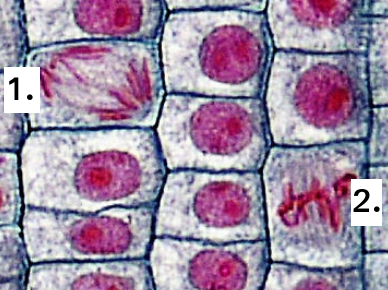
Which of the following correctly identifies the stage of mitosis for each of the cells?
Identification of the phase of mitosis is an important skill.
The position of the chromosomes gives the best clue.
In Prophase, they are spread around the cell, and double stranded.
In Metaphase, the chromosomes are lined up on the spindle equator.
In Anaphase, the chromosomes are moving to opposite poles of the cell.
In Telophase, the two groups of chromosomes are separate, sometimes with a nuclear membrane.
The four cells shown below have each been surrounded by a solution for 1 hour.
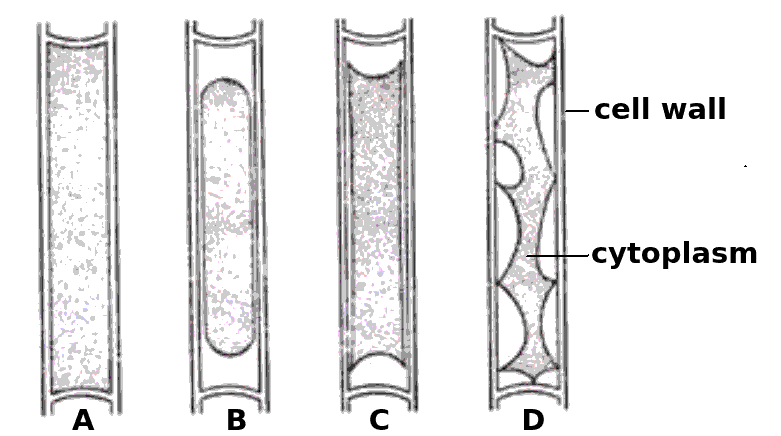
Which cells have been in a hypertonic solution ?
Cell A is swollen turgid, it is in a hypotonic solution or an isotonic solution.
The cells B, C and D show increasing signs of plasmolysis, and so they must be in hypertonic solutions.
Skill: Estimation of osmolarity in tissues by bathing samples in hypotonic and hypertonic solutions. (Practical 2)
Which property of phospholipid molecules describes the fact that they have both hydrophobic and hydrophilic parts?
Phospholipids form bilayers in water due to the amphipathic properties of phospholipid molecules. The hydrophobic tails attract each other and the hydrophilic phosphates are attracted to the water.
Why is it that prokaryotes can divide by the simple process of binary fission, but eukaryotes have to divide by the more complex process of mitosis?
To explain how the structure of prokaryotes allows them to divide by binary fission you could mention:
- Prokaryotes have a single chromosome, eukaryotes have multiple chromosomes
- Prokaryotes have no nuclear membrane, which eukaryotes have.
This electron microscope image shows a group of prokaryotes.
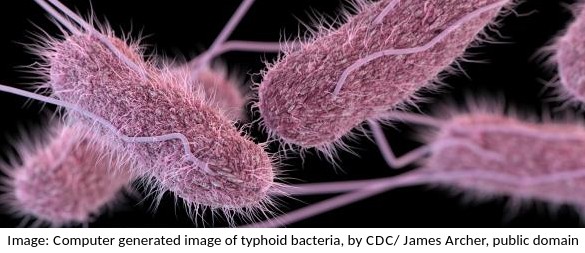
What structures are most likely to be found inside these cells?
Skill: you should know how to draw prokaryotic cells (with a cell wall, plasma membrane, cytoplasm, pili, flagella, 70s ribosomes and nucleoid.) and eukaryotic cells (free 80s ribosomes, rough endoplasmic reticulum (rER), lysosome, Golgi apparatus, mitochondrion and nucleus)
Cell theory covers most, but not all cases.
Which one of these statements is an exception?
Exceptions to cell theory are : multinucleated striated muscle the giant single celled Acetabularia algae?
Also, organisms consisting of only one cell carry out all functions of life in that cell. e.g. Paramecium, Chlorella.
What is the importance of surface area to volume ratio to cells?
Surface area to volume ratio is important in the limitation of cell size. The lager the volume, the greater the need for materials which have to be exchanged over the surface of the cell.
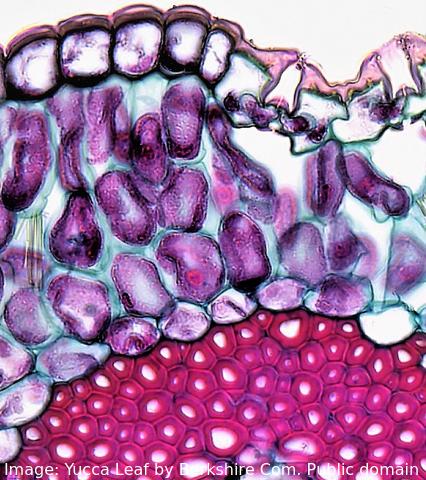 The image shows a range of different cell types in the leaf of a Yucca plant.
The image shows a range of different cell types in the leaf of a Yucca plant.
How do stem cells form this range of cells?
What is the process called?
Specialised tissues can develop by cell differentiation in multicellular organisms.
Differentiation involves the expression of some genes and not others in a cell.
The blood cells below were imaged using an electron microscope.
The magnification is x3000 and the ruler measures the central cell as being 2 cm in diameter.
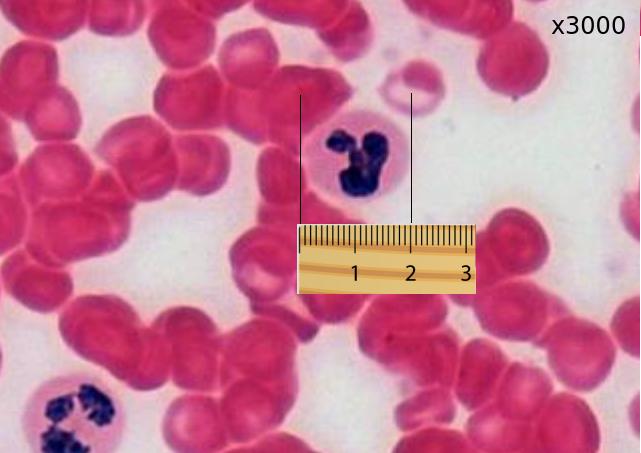
Estimate the actual size of this white blood cell.
Calculate specimen size using magnification?
First change the size measurement into µm units = 20000µm
Then divide by the magnification. 20000 / 3000 = 20 / 3 = 6.6 µm
Cells are often stored in isotonic conditions because they can be damaged in other concentrations, hypertonic, or hypotonic. Which of the descriptions of hypertonic is the most accurate?
Hypertonic solutions have a higher concentration of solutes, and lower water potentials than cells.
The 64 codons in the genetic code give rise to the same amino acids in nearly all organisms.
There is very little variation. This is evidence for a single common origin of life.
Differences in the frequency of amino acid use reflects the different genes in the two organisms.
Which is the best definition of a tissue?
Comment:Tissues may have one or several cell types and one or more functions
Which of the following could be used to distinguish a living from a non- living object
Comment: Inanimate objects can move, produce and utilise energy but the process of respiration is exclusive to living systems
Which organelle in a eukarytotic animal cell synthesises proteins for exocytosis?

The RER synthesises proteins for exocytosis.
The image is of a prokaryotic cell. Which feature defines the cell as prokaryotic?

The lack of a membrane bound nucleus (nucleoid) classifies a cell as prokaryotic.
Which organelles are found in large numbers in secretory cells in animals? I Vesicles II Golgi Body III Mitochondria IV Rough endoplasmic reticulum.

Secretory cells synthesise proteins for exocytosis so have large numbers of mitochondria to supply energy, RER to synthesise the proteins for packaging into vesicles by the Golgi Body.
Which means of transport across a plasma membrane requires the molecule shown in the picture?

Identify the stage of mitosis of cells 1 and 2

In cell 2, the chromatids are aligned on the equator (seen from above)- Metaphase. In cell 1, the chromatids are moving towards the poles - Anaphase.
A tissue is placed in an isotonic solution. Which of the following is the best description of water movement between the tissue and the solution?
There is no net water movement, gain and loss from the tissue is equal in both directions.
Refresh this page to try a new set of 20 multiple choice questions. The questions will be different next time you visit. Great revision.

 Twitter
Twitter  Facebook
Facebook  LinkedIn
LinkedIn